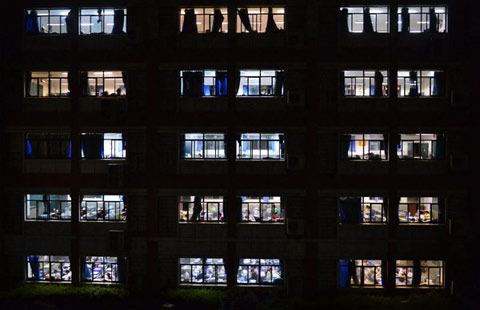Standoff in the sand
Updated: 2014-06-20 07:20
By Sun Yuanqing (China Daily)
|
||||||||
Ancient city ruins in China's western deserts battle the toll of time as officials and conservators seek to protect and preserve the heritage of the old Silk Road, Sun Yuanqing reports from Gansu province.
Editor's Note: The Silk Roads: The initial Section of the Silk Roads, the Routes Network of Tian-shan Corridor has been nominated to be inscribed on UNESCO's World Heritage list. The result of this international application involving China, Kazakhstan and Kyrgyzstan will be released later this week during the 38th session of the World Heritage Committee currently being held in Doha, Qatar. The application included 33 historical sites, which includes 22 in four of China's provincial-level administrative regions: Shaanxi, Henan and Gansu provinces, and the Xinjiang Uygur autonomous region (with exclusion of two sites on the route, which have already been listed as World Heritage sites - the Mogao Caves and Longmen Grottoes) plus eight in Kazakhstan and three in Kyrgyzstan.
The air smells of sand. The sky has turned a murky, reddish color. The wind has become so violent that it is impossible to keep our eyes open or our feet firmly on the ground. The sand, whipped up by the wind, strikes the window sharply. This administration office of the Suoyang City ruins in Gansu province in Northwest China has become a little desert in itself. The only peaceful creature is the white puppy that the staff members have adopted, one of the few distractions they have in the desert.
Scattered through the Gobi desert, the Suoyang City ruins, along with other sites on a network of routes of Eurasian trade and cultural exchanges, has survived sandstorms like this for more than 1,000 years. Once the center of ancient civilization, the Silk Road waystations have been neglected, discovered, excavated and now await rediscovery.
Chinese officials and conservators are taking all kinds of measures to resurrect the route's former glory, in a joint initiative with Kazakhstan and Kyrgyzstan to seek UNESCO's World Heritage status for the Silk Road. The result is going to be announced later this week.
Not only have the relics been preserved, but the site has also been revamped to be more tourist-friendly. China has also launched ambitious efforts to turn the desert into an oasis that will better nurture the relics.
"The change is vast," says Cai Chao, executive director of the Gansu section of the Silk Road and architect at the Institute of Architectural History, a major planner for the project. "This area has always been a hot spot for experts and archaeologists. Now it has also become a place for ordinary people to look back at history."
The work started from within. In the Yumen Pass, a frontier pass leading to the north from the ancient Chinese territory, the missing parts are mended with adobe made from original material and ramming craftsmanship.
The surface of the relics is sprayed with anti-weathering material developed by the Conservation Institute of Dunhuang Academy, which has been responsible for the conservation of major sites on the Silk Road, while the cracks are filled with grouting materials.
A total of 5 million yuan ($803,000) has been invested in the monitoring system that records the temperature and humidity of the relics.
"The dry climate in the area makes it easier to preserve earthen ruins. It would have been impossible in the south," says Guo Qinglin, deputy director of the Conservation Institute of Dunhuang Academy.
To allow people to better understand the value of the relics, a large-scale renovation of the sites was launched in 2006.
Until the early 1980s, the Big Fangpan Castle in the Yumen Pass was used as a sheepfold for the local farmers, says He Guowu, head of the administration office of the Yumen Pass.
In 2012, Cai and his team started restoration work on the site. Mines near the site were shut down. Now people can follow the wooden trestle that leads into the castle, where a glass-clad platform has been built so visitors can see the interior of the castle without causing damage.
The high steel fence around the castle has been replaced with knee-high steel posts, allowing a better view. "The substitute is rather simple and cheap, but it has been proved very effective," says Cai.
The administration house has been painted with brown earth, which blends with its surroundings.
While severe sandstorms are rare, the fact they can be a threat has led to calls to provide a better environment for the relics. In the Suo-yang City ruins in Guazhou county, the biggest threat is sandstorms.
Next year, the county will invest 2.8 million yuan to develop a sand-blocking dam, put down grass grids and plant more than 50,000 trees near the Suoyang City ruins to conserve water and reduce wind abrasion.
Cai's team has designed a whole defense system specifically for the site, which surrounds the ruins with three layers of plants of ascending heights to slow down the wind approaching the site.
But they need more technicians who can work onsite on a daily basis, says Xie Yanming, head of the management office of the Suoyang City ruins.
"People come and go. Few of them will stay in the desert," he says.
Twenty-eight people were hired in the past six months. Most of them work two or more jobs. The bookkeeper also works as cashier while the tour guides work as receptionists.
"There are too few technicians at the site. If the small problems can be solved in time, the big ones will be avoided," says Guo from the Conservation Institute of Dunhuang Academy.

 Council of Fashion Designers of America Awards
Council of Fashion Designers of America Awards
 Fan Bingbing, first Chinese actress in Barbie Hall of Fame
Fan Bingbing, first Chinese actress in Barbie Hall of Fame
 Awarding ceremony of 2014 hito Pop Music held in Taipei
Awarding ceremony of 2014 hito Pop Music held in Taipei
 Zhao Liying's photo shoot for Children's Day
Zhao Liying's photo shoot for Children's Day
 'Taken 2' grabs movie box office crown
'Taken 2' grabs movie box office crown
 Rihanna's 'Diamonds' tops UK pop chart
Rihanna's 'Diamonds' tops UK pop chart
 Fans get look at vintage Rolling Stones
Fans get look at vintage Rolling Stones
 Celebrities attend Power of Women event
Celebrities attend Power of Women event
Most Viewed
Editor's Picks

|

|

|

|

|

|
Today's Top News
'Expansion not in Chinese DNA'
Xi's ROK visit 'a milestone': US envoy
Chinese jeweler buys Hearts On Fire
Chinese stories, Hollywood thrills
Beijing, Hanoi vow to act on friction
Huawei gets insurance help in Europe
Wal-Mart to triple efforts on food safety
US captures Benghazi suspect in raid: Pentagon
US Weekly

|

|







